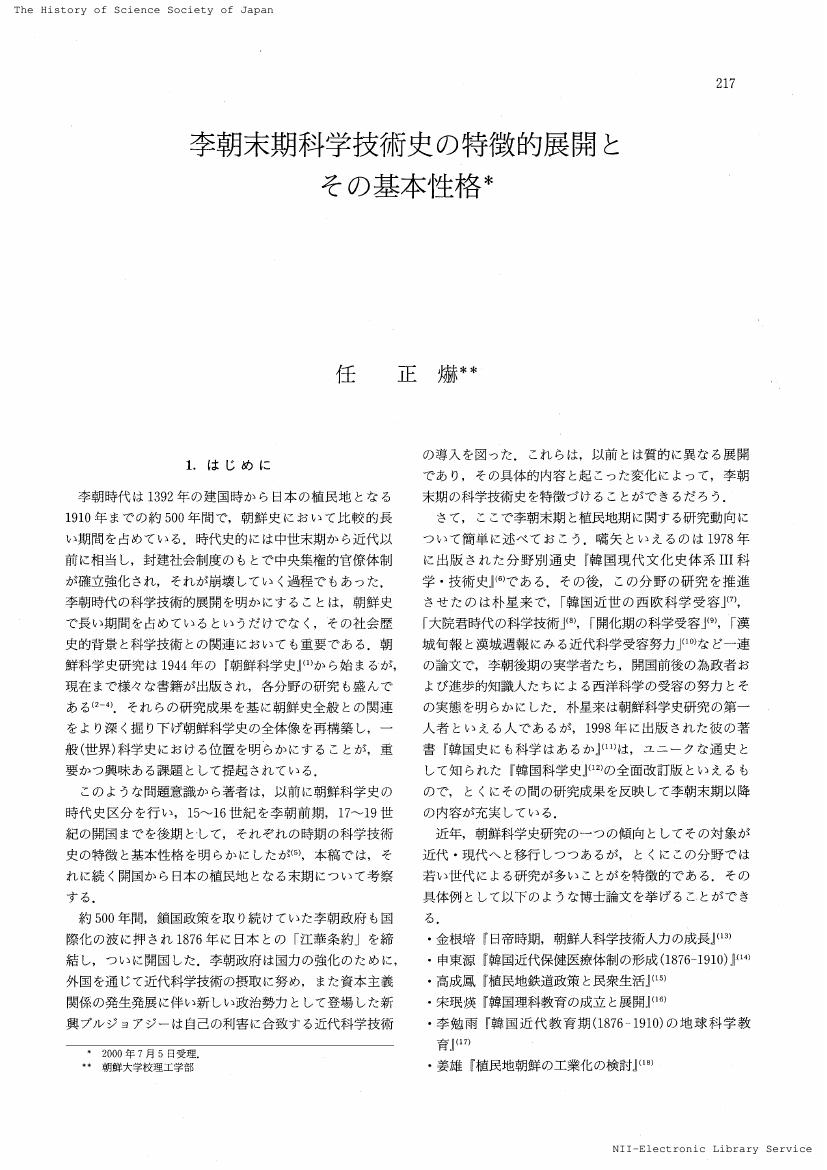1 0 0 0 OA 李朝末期科学技術史の特徴的展開とその基本性格
- 著者
- 任 正爀
- 出版者
- 日本科学史学会
- 雑誌
- 科学史研究 (ISSN:21887535)
- 巻号頁・発行日
- vol.39, no.216, pp.217-222, 2000 (Released:2021-08-23)
1 0 0 0 OA 志筑忠雄「混屯分判図説」の検討とその科学史的評価
- 著者
- 任 正爀
- 出版者
- 日本科学史学会
- 雑誌
- 科学史研究 (ISSN:21887535)
- 巻号頁・発行日
- vol.39, no.214, pp.77-87, 2000 (Released:2021-08-23)
In this paper, the Kon-ton bun-pan zu-setu by SIZUKI Tadao that is well known as the original theory for the formation of solar system in Japan at the 18th century is discussed in detail. Firstly the analogy with the nebular hypothesis by Kant is pointed out. Although Shizuki applies a few principle of the Newton mechanics, the Kon-ton bun-pan zu-setu is characterized as natural philosopy because it is rooted in the "ch'i " that is a traditional cosept in the Oriental philosophy. By comparison of the cosmology by HON tae-yong who was a practical sciensist in Korea with the cosmology by Shizuki the stage of oriental cosmology in the 18th century is indicated.
1 0 0 0 OA アゴラ 朝鮮民主主義人民共和国における科学史研究
- 著者
- 任 正爀
- 出版者
- 日本科学史学会
- 雑誌
- 科学史研究 (ISSN:21887535)
- 巻号頁・発行日
- vol.32, no.185, pp.48-51, 1993 (Released:2021-03-23)
1 0 0 0 OA 朝鮮における独自的な宇宙論の発展について
- 著者
- 任 正爀
- 出版者
- 日本科学史学会
- 雑誌
- 科学史研究 (ISSN:21887535)
- 巻号頁・発行日
- vol.30, no.180, pp.242-250, 1991 (Released:2021-04-03)
1 0 0 0 OA 朝鮮の実学者洪大容の地転説について
- 著者
- 任 正爀
- 出版者
- 日本科学史学会
- 雑誌
- 科学史研究 (ISSN:21887535)
- 巻号頁・発行日
- vol.29, no.176, pp.201-208, 1990 (Released:2021-08-30)
Hong Tae-Yong was both a philosopher and scientist in 18th century Korea. The fact that he proposed the roating earth theory is well known, but the appreciate for it has not been established. In this paper, firstly the previous investigations are surveyed and indicated a problem in there. In the many cases the originality is discussed in the connection with Copernican theory without the examination of Hon's own writing "Uisan mundap" mentioned the roating earth theory. Thus, secondly examinating "Uisan mundap" the characteristics of his roating earth theory and why Hong could propose his theory are considered. Hong's roating earth theory is a moment of the development into the infinite universe theory and a part of his cosmology. There his relativism and the mechanical viewpoint to nature played the important roles
1 0 0 0 OA 朝鮮医学史研究の近年の動向について
- 著者
- 任 正爀
- 出版者
- 日本科学史学会
- 雑誌
- 科学史研究 (ISSN:21887535)
- 巻号頁・発行日
- vol.57, no.287, pp.201-207, 2018 (Released:2021-01-24)


